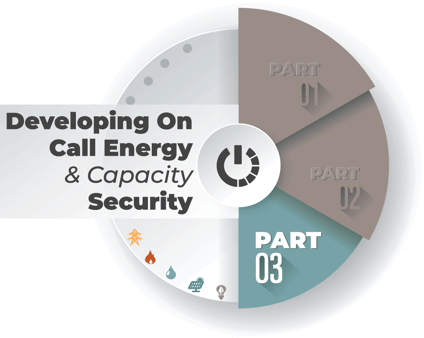- Home
- Services
- Hi-Line Engineering
- About
- Careers
- Contact
- Requests For Proposals
Developing On Call Energy & Capacity Security - Part 3
by GDS Associates, Inc | December 4, 2023 | Newsletter - TransActions
 JOINT PROJECT OWNERSHIP
JOINT PROJECT OWNERSHIP
As provided in Part 1 and Part 2 of this three-part series, there are industry proven power project development and asset management processes which can be utilized to effectively develop, own, and manage a natural gas fired generation resource. The last of a series of three articles, this article outlines the process and provides a framework that can be followed when a joint development and joint ownership structure is put in place to develop, build, and operate the project.
JOINT PROJECT OWNERSHIP STRUCTURE 
Depending on the power project’s ownership structure, a joint ownership and development strategy can require a level of talent resource engagement that is the same as or similar to that of a sole ownership strategy. That is, the lead owner would likely provide the required talent resources, either internally and or externally. However, this level can be impacted by the terms of the joint development, ownership, and operating agreements agreed to by the owners. Further, the need for joint ownership agreements creates additional complications and considerations relative to those issues for sole ownership.
Figure 2 represents the implementation functions and the required talent resources needed for power project development under a joint project ownership structure. In cases where all the owners lack the experience and/or resources, or for reasons such as conflict of interest, the owners can agree to outsource these activities and define the roles and responsibilities within the joint project agreements. Under a joint project strategy, owners’ legal and owners’ representative support will need to be well versed in joint project agreements that will be required. 
Owners who are not leading the development efforts will require their own support services to help protect their interests during the project development process and after commercial operation. These services can be sourced in-house or contracted separately by the non-lead owner. Such owner representative services would not be part of the project nor be a joint project expense. The ability of any owner to monitor and challenge, if necessary, project management directions and decisions based on experts’ reviews would need to be outlined in the joint project agreements.
JOINT PROJECT INTERNAL STAFFING
Joint ownership will require internal talent resources during both project development and commercial operation. The breadth and depth of the internal talent resources will depend on the terms of the joint project agreements in place to manage the project development and operations. The project development and operations resources are generally housed within the project’s lead functional organization. Existing internal resources are often relied on by the lead owner to drive functional activities that can be viewed as outside the plant fence such as power transmission and fuel procurement, but it is not uncommon for such expertise to be outsourced. The degree of engagement will depend on the joint agreements in place to manage the project.
The project-lead organization will design the outsourced talent resources’ reporting relationships that best fits their managerial situation. A development lead or project manager will be required to coordinate and oversee their team of engaged internal and outsourced resources. In addition, the project lead will be the organization’s project “go to” person. Although this individual would report to the lead owner's senior management, they would be accountable to other owners as well.
 SUMMARIZING THE EFFORT
SUMMARIZING THE EFFORT
Natural gas fired power project development includes a range of implementation functions. These functions require both technical and commercial skillsets. The development and implementation resources must be qualified to support the execution of each function. It will be critical for these internal and acquired resources to meld the development activities so that the project can be commercialized to meet its goals.
Regardless of the chosen development strategy, the resulting structures will generally include the same types of technical and commercial talent, but the level of engagement of these resources will differ.
Best practices require the formal engagement of an owner’s engineer when an EPC contract or developer arrangement is the determined approach. This is an expected requirement for funding approval. It is best practice for a co-owner not experienced in power project development and operations and with limited internal project development talent, to engage an owner’s representative to act as an extension of the co-owner’s development and operations staff.
Organizations without the power project development, ownership, and operations internal resources and experience have successfully evolved while also maintaining a lean approach to fulltime internal staffing. The required high level of project development and operations proficiency can be successfully acquired through outsourcing. Organizations will acquire power project internal talent and outsourced talent resources and design reporting relationships that best fit their organization’s managerial situation. During the development phase, the reporting relationships will need to operate much like a matrix organization with dual reporting to both the organization’s internal leads and the project’s development lead to be successful.

 For more information or to comment on this article, please contact:
For more information or to comment on this article, please contact:
Paul Wielgus, Managing Director
GDS Associates, Inc. - Marietta, GA
770.799.2461 or
paul.wielgus@gdsassociates.com
GET OUR NEWSLETTER
RECENT POSTS
- Why MOD-026-2 Matters: Raising the Bar for Generator and IBR Modeling Reliability
- Exploring the 2026-2028 Reliability Standards Development Plan
- Blackstart Resource Availability During Extreme Cold Weather Conditions
- DOE Pushes FERC to Accelerate Large Load Grid Access
- Building a Cyber-Aware Workforce in the Utility Sector
Archives
- December 2015 (8)
- June 2025 (7)
- January 2016 (6)
- July 2016 (6)
- March 2021 (6)
- May 2022 (6)
- August 2020 (5)
- March 2015 (4)
- January 2019 (4)
- June 2019 (4)
- August 2019 (4)
- February 2020 (4)
- May 2020 (4)
- June 2020 (4)
- December 2020 (4)
- July 2021 (4)
- October 2021 (4)
- April 2024 (4)
- December 2024 (4)
- May 2025 (4)
- April 2015 (3)
- August 2016 (3)
- February 2017 (3)
- July 2017 (3)
- February 2018 (3)
- February 2019 (3)
- November 2019 (3)
- March 2020 (3)
- April 2020 (3)
- September 2021 (3)
- December 2021 (3)
- August 2022 (3)
- December 2022 (3)
- April 2023 (3)
- July 2023 (3)
- December 2023 (3)
- September 2024 (3)
- October 2025 (3)
- December 2025 (3)
- May 2014 (2)
- February 2016 (2)
- March 2016 (2)
- September 2016 (2)
- November 2016 (2)
- January 2017 (2)
- July 2018 (2)
- November 2018 (2)
- March 2019 (2)
- May 2019 (2)
- July 2020 (2)
- September 2020 (2)
- April 2021 (2)
- August 2021 (2)
- October 2024 (2)
- September 2025 (2)
- February 2014 (1)
- April 2014 (1)
- July 2014 (1)
- August 2014 (1)
- November 2014 (1)
- February 2015 (1)
- May 2015 (1)
- June 2015 (1)
- November 2015 (1)
- October 2016 (1)
- December 2016 (1)
- October 2018 (1)
- December 2018 (1)
- April 2019 (1)
- July 2019 (1)
- September 2019 (1)
- October 2020 (1)
- November 2020 (1)
- February 2021 (1)
- April 2022 (1)
- July 2022 (1)
- October 2022 (1)
- August 2023 (1)
- October 2023 (1)
- July 2025 (1)
- November 2025 (1)
Categories
- Newsletter - TransActions (85)
- News (78)
- Employee Spotlight (35)
- Energy Use & Efficiency (28)
- Energy, Reliability, and Security (17)
- Other Specialized Services (11)
- Environment & Safety (10)
- Power Supply (8)
- Transmission (8)
- NERC (7)
- Utility Rates (7)
- Cyber Security (5)
- Energy Supply (4)
- Hi-Line: Utility Distribution Services (4)
- Battery Energy Storage (3)
- Uncategorized (2)
- Agriculture (1)
- Hi-Line: Seminars & Testing (1)